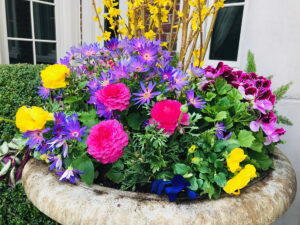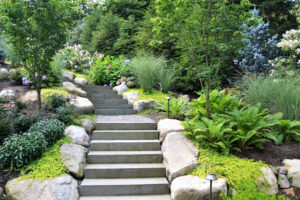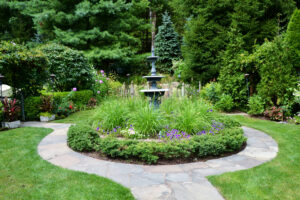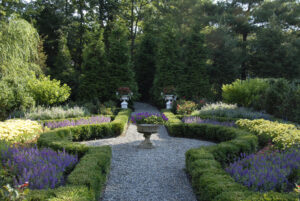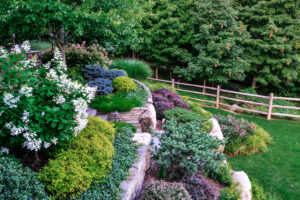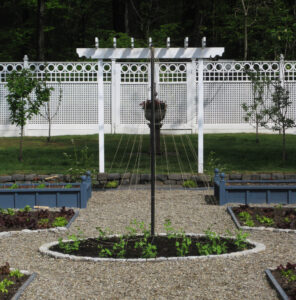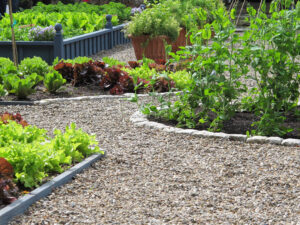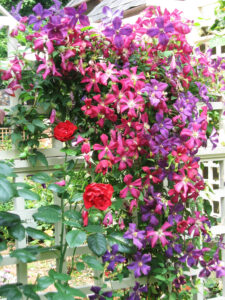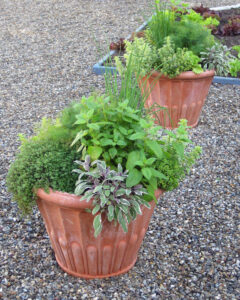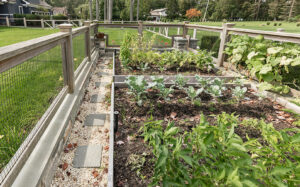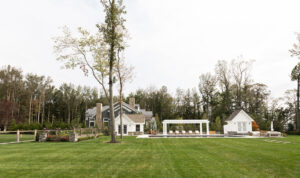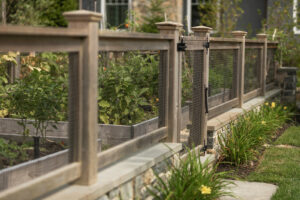Early Spring in the Garden
Three landscape designers give us their tips
Spring is in the air — and on the calendar this coming Saturday. To celebrate warmer weather, we spoke to three landscape professionals about things to do now for a great garden throughout the growing season.
Mitchell Knapp | Scenic Landscaping
Haskell, NJ | 973-616-9600 | ScenicLandscaping.com
Photos: Heather Knapp
GET STARTED March is the most important time of the year for a garden — there’s a lot to do. As the snow melts, it’s time to get to work. Think about what you want to get out of your garden. Vegetables such as carrots and potatoes need to be planted early. You can also plant annuals that can survive a frost such as pansies or Johnny Jump Ups.
PREP THE SOIL Get the soil prepped — till it, break it apart, loosen it up. After a long winter, the soil has been depleted of nutrients and needs to be fed. When fertilizing, use plant-specific products. Evergreens want a nice evergreen food. Roses want Rose-tone®. Perennials want Plant-tone®. When applying fertilizer, keep in mind that plants don’t like the fertilizer put on them; it should go around the base of the plant.
SPLIT PERENNIALS Because all perennials will need to be cut back, consider splitting them and planting some elsewhere. This time of year is suitable for dividing perennials such as grasses, hostas and liriope because they’re in a dormant stage. It’s advantageous: you can make three plants out of one and get the benefit of additional perennials without having to pay for more. It’s also a good time to cut back woody ornamentals, before the leaves come in, and to clean out all the branches that were damaged by snow.
NOT ALL WINTER DAMAGE IS PERMANENT Many plants will rebound as the weather gets warmer and the sun gets stronger. Don’t force plants into shape or position. Boxwoods may get flattened from the snow, but they’ll perk back up when the temperatures warm.
MULCH PRUDENTLY In addition to its aesthetic appeal, mulch slows down weed growth, helps retain moisture and adds nutrients to the soil as it breaks down. March-into-April is a good time of year to spread a thin layer. Feed the plants first, because mulch can block nutrients. And it’s important not to use too much. About 2 inches is appropriate. You just want to coat the root system, not bury it. Otherwise the plants are going to fight to find the surface and nutrients won’t be absorbed properly.
Susan Cohan | Susan Cohan Gardens
Boonton, NJ | 201-572-1502 | SusanCohanGardens.com
Photos: Susan Cohan
KEEP WEEDS AT BAY Weed early; weed often. I’m a really big believer in that. It will make you so much happier when it’s hot and miserable in June.
START EARLY VEGETABLES AND FLORALS Certain cold-weather vegetables — such as radishes, beets, kale, spinach and Swiss chard — can be planted in March. You can plant peas when the soil temperature reaches 40° to 45°F, which should be in the next couple of weeks. You can start planting florals as soon as the soil warms up reliably to 50° or 55°. I’ve planted roses as early as the first or second week in April, depending on what the weather report says.
PRUNE WITH A PURPOSE Rose pruning should happen in mid-March. Cut away any parts that died over the winter. Start training roses, particularly climbers. The earlier you do that, the more successful your roses will be. Prune boxwoods or other evergreen hedging plants when they show new growth. You want to cut new growth to open up the plant and let air and sunlight into the center. The biggest mistake I see is pruning only the outside of the plant.
TRY AN ALTERNATIVE TO MULCH My style is more naturalistic. I’m a big proponent of planting green “mulch.” I like the look of ground covers that create a dense matte, like thyme or any kind of low perennial. I’ve also used pea gravel in the gardens I’ve done lately. It helps keep the soil temperature and moisture even, which is really the point of mulch, though most people think it’s decorative. Pea gravel is also great for paths; it makes a delightful sound when you walk on it.
BE PATIENT Plants need time. If you planted bulbs last fall, for example, they might not put on the biggest show this first year. That doesn’t mean they’ve failed. Some plants, such as peonies and iris, take a few years to settle in and very often won’t bloom at all until the second year.
TAKE TIME TO (LITERALLY AND FIGURATIVELY) STOP AND SMELL THE ROSES The most important thing — and I say this as a professional and also as someone who has a home garden — is to enjoy it. Once a garden really starts to grow, it can become a chore. We have enough chores. So keep it a manageable size and don’t feel that, if a plant dies, it’s necessarily your fault. Plants are like people; they’re individuals. Some are healthy and some aren’t. Some are stubborn and won’t give up the ghost; others die quickly. I’ll try a plant three times. If it doesn’t survive the third time, I make peace with the fact that I’m just not going to grow it.
Ivan Mazur | By Design Landscapes Inc.
Lakewood | 732-901-5566 | ByDesignLand.com
Photos: Shaun Thomson
DO SOME PRE-PLANTING PREP Now’s the time to figure out exactly what you want your garden to look like. Consider where you’re going to locate both the garden and the plants within the garden. Decide whether you’re going to do raised planters. Start prepping your bed areas by tilling and fertilizing. And it’s not too late to start seeds indoors for plants such as tomatoes.
GET A JUMP ON WEEDS One of the most important things people tend to overlook is putting pre-emergent weed preventer in their garden beds. You can set yourself up for success by using pelletized weed preventer. It interrupts the life cycle of weeds. Scatter it generously into your beds at the beginning of the season. Another thing that shouldn’t be left undone is mulching. If you haven’t done it in at least a year, it’s time to bring in more mulch. That’s going to help suppress weed growth as well.
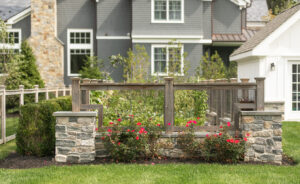
The flowers outside the raised bed are Knock Out® roses (this photo) and daylilies (last photo). Both of these plants have striking colors that attract pollinators to the garden, including bees, hummingbirds and butterflies. They are an attractive border and help a garden to thrive, says Shaun Thomson, a landscape designer at By Design Landscapes. The roses provide some height and structure to a garden, which also can help to provide sun relief to the understory plants that need it, Thompson adds.
WAIT TO PRUNE CERTAIN PLANTS Don’t prune plants such as rhododendrons or azaleas too early. You want to wait until the they’ve bloomed. If you do it prior to blooming, you won’t get flowers.
REMOVE AUTUMN REMNANTS Make sure that any leftover leaves from the fall haven’t accumulated around the bases of the shrubs. Many plants don’t like leaf litter at their bases; it can cause disease.
ADD SOME ANNUALS If you want to get the most out of your garden and have it look its best, supplement existing plantings with annuals. Early annuals that can be planted around this time include marigolds and Wave® petunias. Other plants that add a splash of color in the spring are dianthus and moss phlox.
PREVENT PESTS Be mindful of protecting your vegetable plants from any critters, especially when they’re still young. Raised garden beds will help keep out rabbits. Chicken wire around the edges can help to stop squirrels and larger animals from making a meal of the garden. To keep insects away, use neem oil. It’s an organic way to ward off fungal flies, and it also helps with spider mites and some other common pests. It’s non-toxic for birds, bees and other wildlife.

